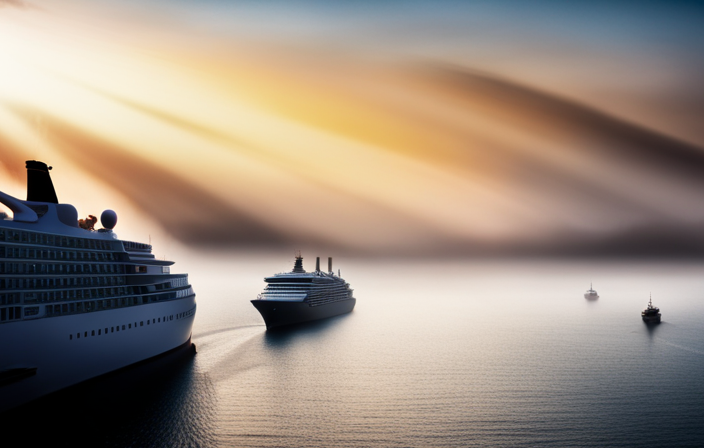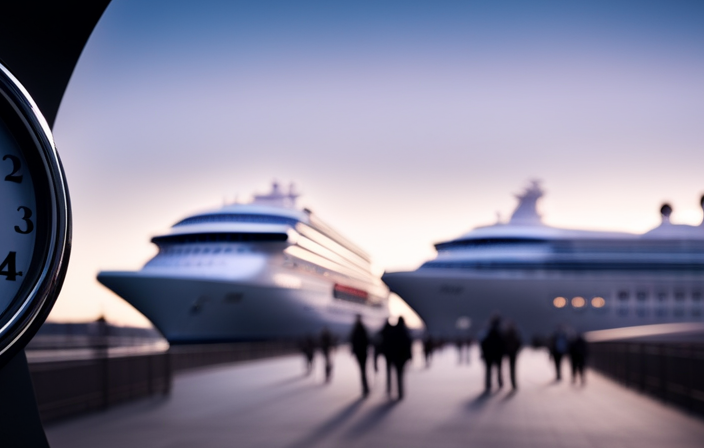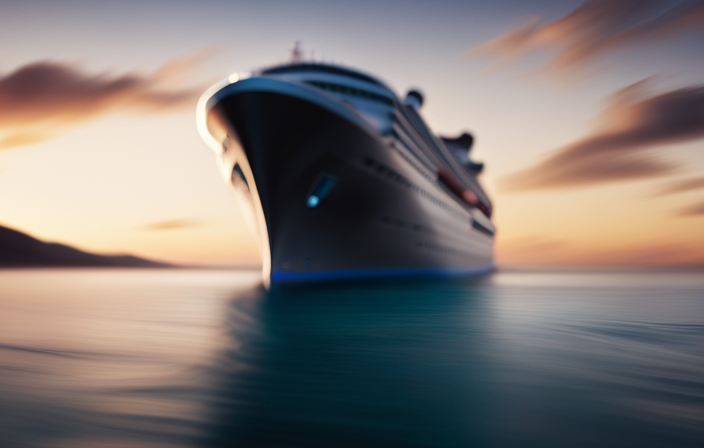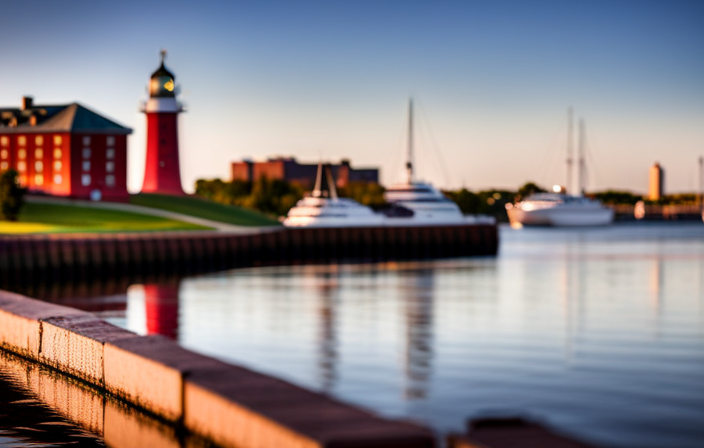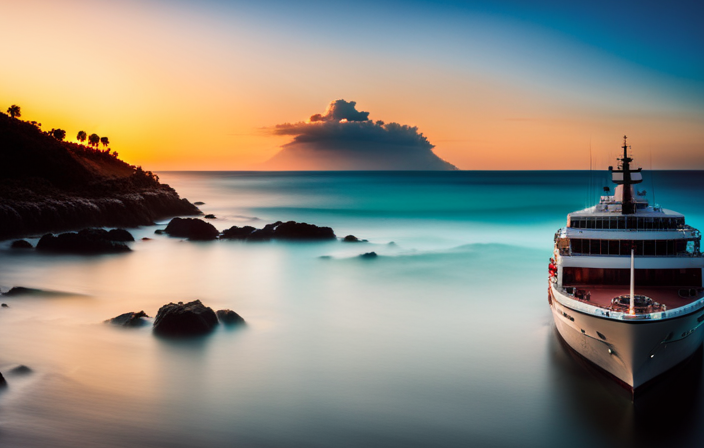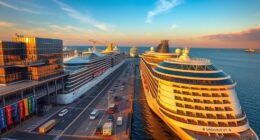You might be asking yourself, “Why does the weight of a cruise ship matter?” Allow me to clarify, the substantial mass of these enormous vessels is not something to take lightly. As a person profoundly fascinated by the marvels of naval architecture, I can assure you that understanding the weight of cruise ships is crucial for their design, stability, and maneuverability.
In this article, we will delve into the intricate details of how heavy these floating cities truly are.
From the enormous size and weight distribution to the factors that contribute to their overall weight, we will explore it all.
We will also discuss the importance of stability in cruise ship design and how the weight of passenger accommodations, machinery, and equipment play a role.
Moreover, we will touch upon the challenges faced when maneuvering and docking these heavy ships.
So, if you’re ready to dive into the technical aspects of cruise ship weight, grab a cup of coffee and join me on this enlightening journey.
Key Takeaways
- Structural integrity is crucial for supporting the weight of cruise ships, and a combination of high-strength steel and lightweight materials is used in their construction.
- Maneuvering and docking heavy cruise ships present challenges due to limited maneuverability in narrow channels and crowded ports, as well as the influence of wind and current. Specialized tugboats and precise coordination between the crew and port authorities are necessary for safe maneuvering and docking.
- Future trends in cruise ship design focus on weight reduction technologies and sustainable materials, such as lightweight materials like aluminum and advanced composites. Energy-efficient systems and equipment also contribute to reducing fuel consumption.
- Materials and engineering play a vital role in cruise ship construction, ensuring strength while minimizing weight. Advanced design and simulation techniques optimize the structural layout, and continuous monitoring systems enable timely maintenance and repairs.
The Enormous Size of Cruise Ships
Cruise ships, with their immense size and capacity, are truly awe-inspiring. These engineering marvels are built with enormous dimensions to accommodate thousands of passengers and crew.
The length of a typical cruise ship can range from 200 to over 1,000 feet, with some even surpassing the height of a 20-story building. These mammoth vessels are designed to provide a comfortable and luxurious experience for travelers, offering a wide range of amenities and activities.
From expansive dining halls and multiple swimming pools to theaters and shopping centers, cruise ships are like floating cities. Understanding the weight distribution on these giants is crucial to ensure stability and safety at sea.
As we delve into this topic further, we will explore the intricate balance required to keep these colossal ships afloat.
Understanding the Weight Distribution on Cruise Ships
When it comes to these magnificent vessels, one fascinating aspect to explore is how the weight is distributed throughout. A weight distribution analysis is crucial for ensuring the stability of cruise ships. The impact of weight on ship stability cannot be underestimated. To evoke emotion, consider this: imagine a ship with an imbalanced weight distribution, tilting precariously on the open sea. Disaster could strike at any moment.
The weight of passengers and crew must be evenly distributed across the ship to maintain stability.
The placement of heavy machinery, such as engines and generators, must be carefully considered to avoid disrupting the ship’s balance.
Fuel and water tanks need to be strategically positioned to maintain stability as they are emptied and refilled.
Understanding the intricacies of weight distribution is vital in ensuring the safety and smooth operation of these colossal vessels. Moving on to the factors that contribute to the weight of cruise ships…
Factors that Contribute to the Weight of Cruise Ships
As you explore the factors that contribute to the weight of these colossal vessels, you’ll discover the immense burden of responsibility carried by every ounce on board.
Weight distribution plays a crucial role in ensuring the stability and safety of cruise ships. The design of these floating cities is meticulously planned to achieve optimal weight distribution. Engineers carefully consider the placement of heavy machinery, fuel tanks, and passenger areas to maintain balance and stability.
Additionally, the materials used in construction are chosen with weight in mind, as lighter materials can reduce overall weight without compromising structural integrity. Stability design is an intricate process that involves complex calculations and simulations to ensure the ship can withstand various sea conditions.
With weight distribution and stability design meticulously accounted for, cruise ships are able to navigate the open seas with confidence and stability. This attention to detail in weight management seamlessly transitions into the subsequent section about the importance of stability in cruise ship design.
The Importance of Stability in Cruise Ship Design
Ensuring stability is paramount in the design of these engineering marvels, allowing passengers to sail with confidence and tranquility. The importance of stability in cruise ship design cannot be overstated, as it directly affects the safety and comfort of everyone on board.
To achieve optimal stability, cruise ships must carefully consider weight distribution. This involves strategically placing heavy components, such as engines and fuel tanks, low in the ship’s hull to lower the center of gravity.
Additionally, the ship’s design may incorporate stabilizers, which are retractable fins that extend from the sides of the vessel to counteract the rolling motion caused by waves.
The distribution of weight and the inclusion of stabilizers work together to minimize the ship’s movement and ensure a smooth sailing experience for passengers.
Exploring the weight of passenger accommodations and amenities follows naturally from considering stability, as these factors also contribute to the overall weight and balance of the ship.
Exploring the Weight of Passenger Accommodations and Amenities
Passenger accommodations and amenities are crucial in determining a cruise ship’s overall weight and balance. They are essential factors to consider in the ship’s design. The weight of passenger cabins, dining areas, entertainment venues, and recreational facilities must be carefully calculated. This ensures optimal weight distribution throughout the ship. Weight distribution analysis is conducted to determine the placement and arrangement of these amenities for maximum passenger comfort and safety. Every piece of furniture, equipment, and decorative feature must be accounted for. Even small variations in weight can significantly impact the ship’s stability. Therefore, meticulous attention to detail is necessary when designing and outfitting passenger accommodations and amenities.
With this understanding, we can now explore the impact of fuel and water on the weight of cruise ships. This further affects their stability and performance.
The Impact of Fuel and Water on the Weight of Cruise Ships
In our previous subtopic, we delved into the weight of passenger accommodations and amenities on cruise ships. Now, let’s shift our focus to another significant factor impacting the weight of these vessels: fuel and water.
-
Fuel Efficiency: Cruise ships require vast amounts of fuel to power their engines and generate electricity. Newer ships are designed with fuel efficiency in mind, incorporating advanced technologies and streamlined designs to reduce fuel consumption.
-
Environmental Impact: The weight of fuel and water directly affects a ship’s environmental footprint. With stricter regulations and a growing emphasis on sustainability, cruise lines are investing in eco-friendly technologies to minimize their impact on the environment.
-
Balancing Act: Cruise ships must strike a delicate balance between carrying enough fuel and water for the voyage while also considering weight restrictions to ensure safe navigation.
As we transition to the subsequent section, we will explore the weight of cruise ship machinery and equipment, shedding light on yet another aspect that contributes to their massive size and weight.
The Weight of Cruise Ship Machinery and Equipment
Get ready to dive into the realm of cruise ship machinery and equipment. A labyrinth of gears and pulleys work in perfect harmony to keep these floating giants afloat.
When it comes to the weight of cruise ships, the machinery and equipment play a crucial role in the overall distribution and stability design. Every component, from the engines to the propellers, is carefully placed and balanced to ensure optimal performance and safety.
The weight distribution is meticulously calculated to maintain the ship’s stability, preventing any unwanted tilting or listing. The machinery and equipment are strategically positioned throughout the ship, taking into account factors such as the ship’s center of gravity and the location of fuel and water tanks.
This meticulous attention to detail ensures that cruise ships can navigate smoothly through the seas, providing a comfortable and secure experience for passengers.
Transitioning into the subsequent section, the role of structural integrity in supporting the weight of cruise ships cannot be underestimated.
The Role of Structural Integrity in Supporting the Weight of Cruise Ships
The key to supporting the weight of these floating behemoths lies in the unwavering structural integrity carefully engineered into every aspect of their design. The role of materials and engineering considerations cannot be overstated in this regard.
Cruise ships are constructed using a combination of high-strength steel and other lightweight materials to ensure maximum strength while minimizing weight. Advanced computer-aided design and simulation techniques are employed to optimize the structural layout and enhance load-bearing capabilities.
The hull, decks, and bulkheads are designed to withstand the immense forces exerted by the ship’s weight and the dynamic loads encountered at sea. Additionally, the integration of advanced monitoring systems allows for continuous evaluation of the ship’s structural health. This ensures early detection of any potential issues and enables timely maintenance and repairs.
Transitioning to the challenges of maneuvering and docking heavy cruise ships, precise navigation and sophisticated propulsion systems are essential.
The Challenges of Maneuvering and Docking Heavy Cruise Ships
Now that we have discussed the crucial role of structural integrity in supporting the weight of cruise ships, let’s delve into the challenges that arise when maneuvering and docking these massive vessels.
Maneuvering and docking heavy cruise ships can be a complex task due to their sheer size and weight. These behemoths, weighing thousands of tons, present several challenges that require careful navigation and precision.
Here are some of the difficulties faced during maneuvering and docking:
- Limited maneuverability in narrow channels and crowded ports.
- The influence of wind and current on ship control.
- The need for specialized tugboats to assist in maneuvering.
- The precise coordination required between the ship’s crew and port authorities during docking procedures.
Successfully maneuvering and docking heavy cruise ships demands a high level of skill and expertise. It is essential to mitigate these challenges to ensure the safety of passengers, crew, and the ship itself.
As we look ahead to the future trends in cruise ship design and weight reduction efforts, it is important to consider the advancements that aim to address these maneuvering and docking difficulties.
Future Trends in Cruise Ship Design and Weight Reduction Efforts
Imagine maneuvering and docking these colossal floating cities, faced with the challenge of narrow channels, crowded ports, and the unpredictable forces of wind and current. In order to address these challenges, cruise ship designers are constantly looking for ways to reduce the weight of these behemoths. Weight reduction technologies and the use of sustainable materials are key areas of focus in cruise ship design. By incorporating lightweight materials such as aluminum and advanced composites, the overall weight of the ship can be significantly reduced without compromising structural integrity. Additionally, the implementation of energy-efficient systems and equipment helps to reduce fuel consumption and further decrease the weight of the ship. The table below provides a visual representation of some weight reduction technologies and sustainable materials used in modern cruise ship design.
| Weight Reduction Technologies | Sustainable Materials |
|---|---|
| Advanced composites | Aluminum |
| Energy-efficient systems | Bio-based materials |
| Lightweight construction | Recycled materials |
| Aerodynamic design | Fuel-efficient engines |
Frequently Asked Questions
How much does a cruise ship weigh on average?
The weight of cargo significantly affects the overall weight of a cruise ship. The impact of structural materials on weight is also important. Both factors must be carefully considered during the design and construction process.
What are the factors that contribute to the weight of a cruise ship?
What factors contribute to a cruise ship’s weight? The weight is influenced by the ship’s size, construction materials, and onboard amenities. Ensuring proper weight distribution is crucial for safety and stability at sea.
How does the weight of passenger accommodations and amenities affect the overall weight of a cruise ship?
The weight of passenger accommodations and luxury amenities significantly impacts the overall weight of a cruise ship. These factors include the weight of cabins, suites, restaurants, theaters, spas, and recreational facilities.
What is the impact of fuel and water on the weight of a cruise ship?
The impact of fuel and water on the weight of a cruise ship is significant. Fuel efficiency affects the ship’s overall weight and has environmental implications due to cruise ship fuel consumption.
How does the weight of cruise ship machinery and equipment affect its overall weight?
The weight of cruise ship machinery and equipment significantly affects the overall weight distribution. It is crucial to consider the placement and distribution of these components to maintain stability and ensure optimal performance at sea.
How Does the Weight of a Cruise Ship Affect its Cleanliness?
When it comes to the cleanliness of cruise ships, the weight of the ship can play a significant role. Heavier ships tend to have more stability, making it easier to maintain cleanliness. According to the dirtiest cruise ships ranking, heavier ships are often ranked higher for overall cleanliness.
Conclusion
In conclusion, the weight of cruise ships is indeed a significant aspect of their design and operation. Like a mighty behemoth gliding through the ocean, these floating giants bear the burden of their immense size.
From the careful distribution of weight to the strength of their structures, every element is meticulously engineered to ensure stability and safety.
As technology advances, efforts to reduce the weight of cruise ships will continue, paving the way for even grander voyages in the future.

